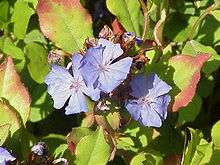Ceratostigma
Ceratostigma (/ˌsɛrətoʊˈstɪɡmə, sɪˌræt-/;[1][2]), or leadwort, plumbago, is a genus of eight species of flowering plants in the family Plumbaginaceae, native to warm temperate to tropical regions of Africa and Asia. Common names are shared with the genus Plumbago.
| Ceratostigma | |
|---|---|
 | |
| Ceratostigma plumbaginoides | |
| Scientific classification | |
| Kingdom: | Plantae |
| Clade: | Tracheophytes |
| Clade: | Angiosperms |
| Clade: | Eudicots |
| Order: | Caryophyllales |
| Family: | Plumbaginaceae |
| Genus: | Ceratostigma Bunge |
| Species | |
|
See text | |
| Synonyms | |
|
Valoradia Hochst. | |
They are flowering herbaceous plants, subshrubs, or small shrubs growing to 0.3–1 m (0.98–3.28 ft) tall. The leaves are spirally arranged, simple, 1–9 cm long, usually with a hairy margin. Some of the species are evergreen, others deciduous. The flowers are produced in a compact inflorescence, each flower with a five-lobed corolla; flower colour varies from pale to dark blue to red-purple. The fruit is a small bristly capsule containing a single seed.
Selected species
- Ceratostigma abyssinicum (Hochst.) Schwein. & Asch.
- Ceratostigma griffithii C.B.Clarke
- Ceratostigma minus Stapf ex Prain
- Ceratostigma plumbaginoides (Bunge)
- Ceratostigma ulicinum Prain
- Ceratostigma willmottianum Stapf
Cultivation and uses
Plants of this genus are valued in the garden for their late summer flower colour and their autumn leaf colour. The following varieties have gained the Royal Horticultural Society's Award of Garden Merit (confirmed 2017):[3]
References
| Wikimedia Commons has media related to Ceratostigma. |
| Wikispecies has information related to Ceratostigma |
- Flora of China: Ceratostigma
- Huxley, A., ed. (1992). New RHS Dictionary of Gardening. Macmillan.
- Sunset Western Garden Book, 1995:606–607
- "Pronunciation Guide". Fine Gardening. Retrieved 2016-01-23.
- "AGM Plants - Ornamental" (PDF). Royal Horticultural Society. July 2017. p. 17. Retrieved 24 January 2018.
- "RHS Plant Selector - Ceratostigma plumbaginoides". Retrieved 5 July 2020.
- Named to honour Ellen Willmott.
- "RHS Plant Selector - Ceratostigma willmottianum". Retrieved 5 July 2020.
- "RHS Plant Selector - Ceratostigma willmottianum 'Forest Blue'". Retrieved 5 July 2020.